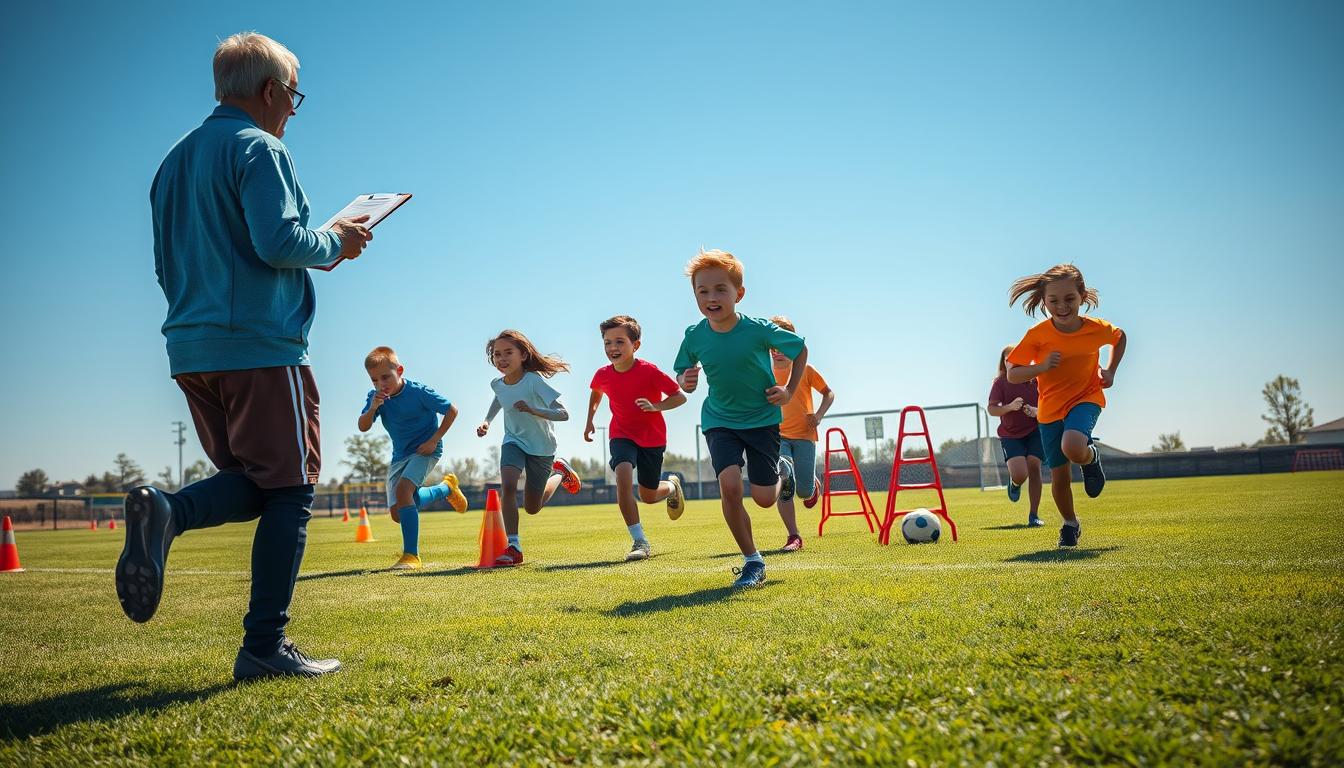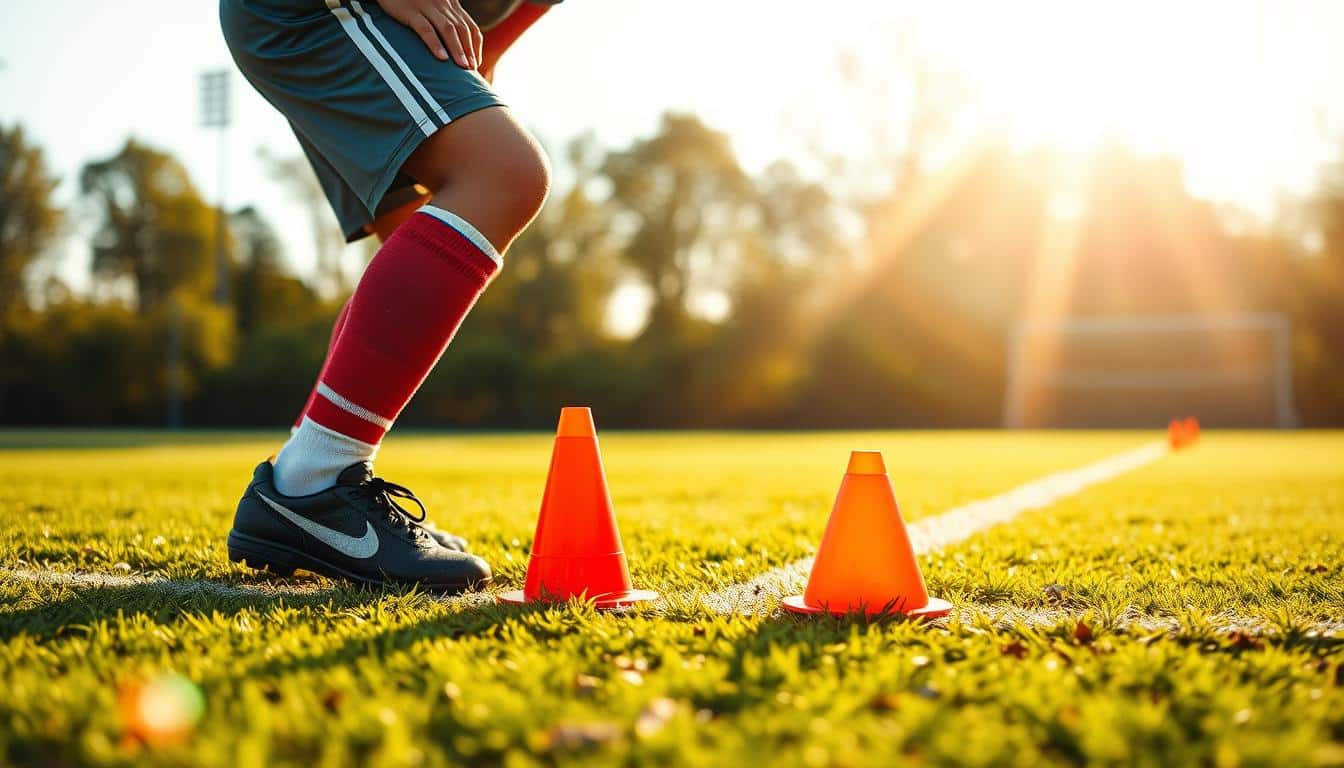Speed Drills for Kids Soccer

Want a simple plan that helps young players run faster and play better on game day?
I will show you quick, clear steps you can use at a park or field. The plan rests on three pillars: relative force/plyometrics, acceleration, and maximum velocity. Each pillar has drills that match how the body moves in a match.
Horizontal plyometrics boost the first step. Vertical work helps players fight gravity and raise top-end running form. I also cover agility and change of direction so kids transfer skills to the game.
My cues are short and safe. You get cone, box, and ladder set-ups. I keep bouts short and rest clear to protect growing bodies. You will coach with confidence and see smiles on the field.
Key Takeaways
- Three training pillars: plyometrics, acceleration, and top-speed mechanics.
- Horizontal and vertical jumps serve different needs in play.
- Simple equipment: cones, boxes, ladder—easy to set up.
- Short work, clean landings, and rest keep kids safe.
- Drills transfer to quick first steps and fast stops in the game.
Why speed matters for young soccer players today
Young players who move faster get more touches, make better passes, and help their team more. That clear edge matters in every game.
Speed in the sport breaks into four parts: pure speed, technical speed, reaction speed, and mental speed. Each part shows up during a match.
Players often cover 7–9.5 miles in a match. Good conditioning keeps movement sharp late and lowers overuse injury risk. I focus on short, fun blocks that build fitness without burnout.
Acceleration comes from body lean and the right shin angle on the first steps. Clean frontside mechanics help a player hold top pace with less strain.
- Reach the ball first and create space in the game.
- Improve control so passing stays calm at higher tempo.
- Train reaction and mental speed to read cues and pick simple, fast options.
I want you to coach short sessions that feel like play. That keeps kids engaged and builds the physical parts that matter most on the field.
Soccer speed drills for kids
Here are simple movement patterns that teach kids how to push harder, land softer, and move with control.
Power skips for height
Set two lines over 15–20 yards. Cue tall posture and strong knee drive. Strike under the hip. Do 2–3 sets of two passes.
Power skips for distance
Use the same 15–20 yards. Push horizontally, swing arms, and “drag the ground” to feel the glutes. Perform 2–3 sets of two passes.
Single-leg broad and box work
Single-leg broad jumps: start on one foot, swing the arms, and land softly. Link double or triple reps. Do 3–5 reps per leg.
Single-leg box jumps: use a low box. Step down — do not jump down. Keep the knee over the foot. Try 3 sets of 3–4 per leg.
Continuous tuck jumps, ladder, and cones
Continuous tuck jumps: pull knees fast and keep ground time short. 2–3 sets of 6–10.
Agility ladder patterns: one foot in each, two feet in each, lateral steps, and icky shuffle. Move arms like a sprint. 2–3 rounds.
Four-cone patterns: set three cones in a line five yards apart and one cone five yards off the middle. Combine sprint, shuffle, sprint across, then backpedal. Do 2–3 rounds.
- Keep contacts snappy and land quiet.
- Chest up and foot under the hip.
- Stop if form breaks — safety first for young players.
| Exercise | Set-up | Reps | Main focus |
|---|---|---|---|
| Power skips (height) | 2 lines, 15–20 yards | 2–3 sets, 2 passes | Vertical force, running form |
| Power skips (distance) | 2 lines, 15–20 yards | 2–3 sets, 2 passes | Horizontal drive, glute engagement |
| Single-leg broad / box | Flat ground / low box | 3–5 reps / 3 sets | Ground contact, balance, control |
| Continuous tuck / ladder / cones | Spot or 10 yards / ladder / cones 5 yards | 2–3 sets / 2–3 rounds | Rhythm, foot speed, agility |
Acceleration drills that teach fast starts and first steps
Nail the first few steps and the rest of the run feels easier. I show short, safe drills that teach lean, push, and turnover.

Falling starts
Raise onto the toes. Lean until you must step. Drive the first step hard with a strong arm swing.
Reps: 4–6. Keep eyes down the field.
Half-kneeling starts
Front knee up. Create a positive shin angle and push through the ground with the front leg.
Reps: 4–6. Switch legs each rep.
Cone start-stop runs
Lay out five cones 5 yards apart over 25 yards. Sprint to a cone, decelerate, step around, then re-accelerate to the next.
Passes: 2–3. Change pace near each cone.
Push-start sprints
Start from a push-up, seated, or prone position. React on a clap and drive long first steps.
Reps: 4–6. Keep posture tall and arms tight to the ribs.
- Cue big, powerful steps before chasing step rate.
- Players run straight when told; only face the opposite direction when the pattern needs a backpedal.
- Rest 45–60 seconds between hard reps to keep quality high.
| Drill | Set-up | Reps / Passes | Main focus |
|---|---|---|---|
| Falling starts | Open space, no cones | 4–6 reps | Forward lean, quick turnover |
| Half-kneeling starts | Flat ground, mark front knee | 4–6 reps | First-step power, positive shin |
| Cone start-stop runs | 5 cones, 5 yards apart (25 yards) | 2–3 passes | Decel and re-accelerate control |
| Push-start sprints | Vary start positions | 4–6 reps | Reaction and long first steps |
Maximum velocity mechanics for safe, smooth top speed
Holding clean mechanics at full pace keeps a young player safe. I want you to teach simple cues that parents can repeat. Keep work short and clear. Stop before form breaks.
A-skips
March first, then skip. Lift ankle, knee, and hip together. Strike under the hip and keep the foot under the body. Do 2–3 sets of 20–30 meters.
B-skips
Lift, then cycle the leg and let it release forward. Do not kick the leg out. Keep posture tall. Repeat 2–3 sets of 20–30 meters.
Straight-leg bounds
Keep knees softly extended. Hold ankles stiff and pull from the glutes. Make small, fast contacts. Try 2–3 sets of 20 meters.
Flying sprints
Build up over 20–30 meters. Fly for 10–20 meters and then shut down. Hold frontside posture, quick clean steps, and low relaxed hands.
- Stack the body: head over ribs over hips.
- Arms: swing straight forward and back; keep hands low.
- Field marker: use a clear end so players know where to ease off.
| Exercise | Set-up | Reps / Distance | Main focus |
|---|---|---|---|
| A-skips | Open lane | 2–3 sets, 20–30 m | Triple flexion, strike under hip |
| B-skips | Open lane | 2–3 sets, 20–30 m | Clean leg cycle, natural release |
| Straight-leg bounds | Short runway | 2–3 sets, 20 m | Glute drive, stiff ankles |
| Flying sprints | Build + fly zone | 3–4 reps, fly 10–20 m | Top pace form, steady steps |
Agility and change-of-direction work kids enjoy
Turn change-of-direction practice into short, fun challenges that build control. I like games that keep attention and teach quick reactions.
Mirror boxes: react, shuffle, and stay square
Build two 5×5 yard boxes with four cones each. One player leads; the other mirrors. The mirror must always face the leader and copy moves.
Leader touches cone tops with a hand. Do 30–90 second rounds. Switch roles 2–3 times. Stay square and keep feet light.
Red light, green light: quick starts and hard stops
Set two parallel lines 30–40 yards apart. You call colors as cues. Green = sprint. Red = stop. Yellow = shuffle. Blue = backpedal.
This trains fast reads and clean stops. Coaches watch hip and chest position to keep the body safe.
Star agility, sprint-backpedal, and a simple course
Star: place one center cone and four cones around it. Sprint out, tap, and return. Rotate to each cone with short rests.
Sprint-backpedal: use a straight lane of cones. Sprint to a cone, backpedal to start. Do 4–6 reps. Keep hips low and chest forward.
Course: link mini hurdles, a ladder, and cone shuttles. Move station to station. Keep lines short and praise quick reactions and balance.
| Activity | Set-up | Key cue | Rounds / Reps |
|---|---|---|---|
| Mirror boxes | Two 5×5 yard boxes, cones | Stay square, touch cones | 30–90s rounds, switch 2–3x |
| Red light, green light | Two lines 30–40 yards apart | Listen to color cues | Short sprints with varied moves |
| Star agility | Center cone + 4 cones | Sprint out & return quickly | Rotate cones, short rests |
| Sprint-backpedal / Course | Lane of cones, hurdles, ladder | Low hips, quick feet, control | 4–6 reps or station laps |
Coaching tips: Keep sessions playful. Cue clean steps and praise fast reactions. Stop when form breaks to keep players safe and confident.
Fun ball-in drills that link speed with control
Use small, repeatable ball tasks to marry tight touches with sudden bursts down the field. I want you to run simple setups parents can manage. Start slow, praise calm control, then add a quick finish.
Bounce and hop with a ball
Dribble in place with small touches. Add two-foot bounces and one-foot hops. Keep the ball close and eyes up.
Sets: 3 x 20–30 seconds. Cue light feet and short touches.
Ladder to sprint with a ball
Run a ladder pattern without the ball, then pick it up and sprint-dribble 10–15 yards to a cone. Repeat 4–6 times.
This links quick footwork to a straight burst. Praise neat control before the run.
1v1 change of direction race
Set two parallel lanes with cones 3–4 yards apart over 12–16 yards. The leader feints, cuts twice, then both race through the end gate. Switch roles each rep.
Dynamic suicides with a ball
Place cones at 5, 10, 15, and 20 yards. Dribble to a cone, turn, and return. Complete all lines, rest, then repeat.
- Cues: soft feet and short touches at turns.
- Finish: pass into space or hit the end cone on the last rep.
- Keep reps short. Stop a set if form breaks and reset with cleaner touches.
| Drill | Set-up | Reps |
|---|---|---|
| Bounce & hop | Spot, ball in place | 3 x 20–30s |
| Ladder → sprint | Ladder + cone 10–15 yards | 4–6 reps |
| 1v1 change | Two lanes, cones 3–4 yds, 12–16 yards | Alternate roles each rep |
| Dynamic suicides | Cones at 5/10/15/20 yards | Complete all lines, rest, repeat |
These short game-like tasks help players link control and finishing in a way that keeps practice fun. Praise neat passing and calm touches first. Then add pace so the young soccer player learns to stay composed in the game.
Conclusion
Wrap the week with clear, simple steps. I suggest a mix of plyometrics, acceleration, mechanics, agility, and ball-in work. Use cones at 5-yard spacing, low boxes, and a ladder to keep set-ups easy.
Start each session with A-skips and a warm-up. Pick two plyometric exercises and two acceleration exercises. Add one top-run like a short flying sprint. Finish with an agility game or a ball-in activity so players leave smiling.
Keep work short, rest full, and place technique before more pace. Do this and your team will grow skills and ability that show up when players run to the end of a game.
